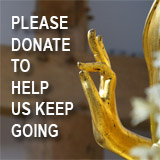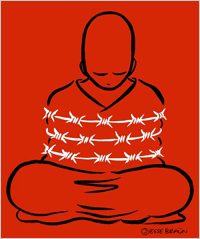
|
|
|
Home Asia Pacific South East Asia Myanmar Myanmar Protest News That was then; this is nowby Ken and Visakha Kawasaki, Insight (Newsletter of Triple Gem of the North), October, 2007Kandy, Sri Lanka -- Between 1975 and 1978, about a third of all Cambodians were killed. The Khmer Rouge outlawed Buddhism, executed almost all monks, desecrated monasteries and pagodas and destroyed millions of books. The radical Maoists were determined to go back to the Year Zero, by eliminating everything that was "foreign," in short, all culture, all civilization, all learning, all Dhamma.
Every refugee we met had witnessed unspeakable horror. Repeatedly, however, we heard that these crimes might be forgiven, but the most monstrous of all acts perpetrated by the Pol Pot regime was the destruction of the Buddha Sasana, which was the glory of Cambodia. In 1986, we were living and working in Japan, but we still visited the Khmer camps on the Thai/Cambodian border, mainly to support the camp monasteries. That summer, we also spent two weeks in Burma, a country we'd visited many times before. At the Sangha University in Rangoon, as we were talking with a group of monks in the library, we mentioned Cambodia.
Soon the monks began talking together animatedly in Burmese. After a few minutes, the librarian asked whether we could carry some things back to the Khmer monks. Of course, we could! The next day, they gave us cloth bags stuffed full of robes, umbrellas, slippers, fans, towels, flags, and Dhamma books. Our good Dhamma friend in Rangoon entrusted us with some Arahat relics from Kyaukse for the Cambodians as well. When we got back to Bangkok, we went immediately to the UNHCR office and asked one of the field officers to arrange for this Sanghdana to be delivered to the monastery in Khao-i-Dang Refugee Camp in Aranyaprethet. A few months later, he sent us an official report, a letter from the monastery committee, and some wonderful photographs of the donation ceremony and the great procession enshrining the relics. It was our pleasure to enable the Burmese monks to be of help to the Cambodian refugee monks. That was then, and this is now. Twenty years later, Burma has become the killing field. In September, monks began leading peaceful demonstrations against the oppressive military government. The generals response was abrupt and violent. Monks were beaten and killed as they chanted the Metta Sutta. Monasteries were raided, and as many as 10,000 monks were arrested. Buddhist Relief Mission immediately sent out an appeal for donations and support. One of the first to respond was the resident monk of a Cambodian monastery in the United States. His devotees not only began meditating and extending metta to the beleaguered Burmese, but the monastery committee voted that part of their Kathina donations would be sent to support the monks of Burma. Soon it will be our pleasure to enable those Cambodian Buddhists to offer assistance, support and encouragement to the Burmese who see their precious Triple Refuge under threat. |
 Get your Korean Buddhist News here, brought to you by BTN-Buddhist Channel |
 |
 The Mandala app brings together Buddhist wisdom and meditation techniques with the latest insights of psychology and neuroscience to handle the challenges and complexities of modern life. The App offers a series of engaging talks and conversations with experts on a wide variety of topics, such as managing stress, dealing with adversity, developing greater resilience, cultivating empathy and compassion, creating healthy relationships, and many more. These topics are explored to help find greater peace, meaning and joy in our lives. Our panel of experts include Dr, Thupten Jinpa, Daniel Goleman, Kelly McGonigal and others.FREE DOWNLOAD here |
| Point
your feed reader to this location |
| Submit an Article |
| Write to the Editor |

 When we worked in Indochinese refugee camps in Thailand and the Philippines, in 1980-81, Khmer refugees told us that they had thrown away their spectacles so that no one would guess that they could read. One student often made his face impassive and blank to demonstrate the "stupid look" he used to fool Khmer Rouge guards. A French teacher explained how he had to feign ignorance whenever a guard spoke French in an attempt to discover anyone with an education.
When we worked in Indochinese refugee camps in Thailand and the Philippines, in 1980-81, Khmer refugees told us that they had thrown away their spectacles so that no one would guess that they could read. One student often made his face impassive and blank to demonstrate the "stupid look" he used to fool Khmer Rouge guards. A French teacher explained how he had to feign ignorance whenever a guard spoke French in an attempt to discover anyone with an education.